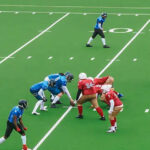More than just a piece of cloth with red and white stripes and a blue triangle, the Puerto Rico Flag represents much more. It is a potent representation of Puerto Rican pride, culture, and history. This article will explore the background, design, and importance of the Puerto Rican flag, explaining its development and the different theories that have been proposed to explain it.
The Design of the Puerto Rican Flag
The rectangular Puerto Rican flag features five horizontal stripes, three of which are red and two of which are white. A white five-pointed star is housed in an isosceles triangle on the top hoist side. The flag’s design, down to the smallest detail, is packed with symbolism.
A. The Red Stripes
The flag’s three red stripes symbolise the lifeblood that keeps the three branches of government functioning harmoniously together.
B. The White Stripes
The white stripes reinforce the concept that the delicate balance between the three parts of government is maintained by individual freedom and the rights of the people.
C. The White Star
The solitary white star at the centre of the flag depicts the Commonwealth of Puerto Rico, highlighting the island’s unique political position and its strong relations to the United States.
D. The Blue Triangle
Puerto Rico is surrounded by the blue triangle of the sky and the ocean. It serves as a constant reminder of the island’s ecological significance.
E. The Triangular Shape
In keeping with the Commonwealth’s republican structure, the triangle’s three sides represent the executive, legislative, and judicial departments of government. This represents the value of a balanced government.
The Historical Origins of the Flag
There are several accounts of where the flag of Puerto Rico first appeared. Grasping the complexities of the flag’s history requires familiarity with the numerous accounts.
A. Presentation in New York
The flag was officially given on December 22, 1895, in New York’s Chimney Hall, which is widely accepted as the definitive date. Juan de Mata Terreforte, a veteran of the “Grito de Lares,” handed the flag to a group of 59 Puerto Rican exiles who were part of the Cuban Revolutionary Party.
B. Inversion of Cuban Flag
The issue surrounds who first came up with the idea to make a flag with the same design as the Cuban flag but with the colours switched around. It is speculated that Francisco Gonzalo (“Pachn”) Marn was responsible for the decision to use the opposite colours from the Cuban flag on the Puerto Rican flag. Some think it was Antonio Vélez-Alvarado who had the concept, while others suggest Manuel Besosa presented the inversion.
C. The Role of Manuel Besosa
Key to the design of the flag was Manuel Besosa, one of the directors of the Puerto Rican branch of the Cuban Revolutionary Party. After a vote against Terreforte’s proposal to make the Flag of Betances (Grito de Lares Flag) the official flag of Puerto Rico, the Directorate asked Besosa to create a new flag with the colours reversed. He enlisted his daughter, María Manuela (“Mima”) Besosa, to embroider the flag. When the Flag of Puerto Rico was established in 1895, it was displayed on a little flagpole at Chimney Hall.
The Color of the Triangle
The controversy around the true hue of the blue triangle in the flag’s design is an interesting footnote. It is generally agreed that the blue on the Cuban flag was a dark one, however the exact shade of blue used in the Puerto Rican flag is not specified. In certain iterations of the flag, the triangle is navy blue, while in others it is either sky blue (“azul celeste”) or royal blue. Different flags have been created due to the lack of a “official” hue of blue.
The Influence of Historical Flags
The history of Puerto Rico is crucial to comprehending the significance of its flag’s design and colour scheme. The flag’s traditional republican colours of red, white, and dark blue date back to Europe’s nineteenth century. The tricolour flag of the First French Republic served as inspiration for these hues; the flag of the newly formed United States had done the same. In 1851, General Narciso López failed in his attempt to annex Cuba to the United States and it was in New York that he fashioned the first Cuban flag with dark blue stripes. The dark blue of the Cuban flag was kept when it was formally recognised as the flag of Cuba in 1903.
Official Recognition
In 1952, the Flag of Puerto Rico was formally proclaimed as the flag of the Commonwealth. This affirmation furthered the monument’s status as an emblem of Puerto Rican independence and national pride. Puerto Rico’s unique political position and rich history are now permanently symbolised by a flag that flies over the whole island.
The Flag’s Significance
The Puerto Rican flag is more than just a symbol; it is deeply meaningful to the island’s culture and people. It reflects their perseverance, quest for self-determination, and connection to their roots. As a symbol of solidarity for Puerto Ricans everywhere, the flag is frequently flown during rallies, parades, and other public events.
Conclusion
The Puerto Rican flag is an iconic and varied representation of the island’s rich history, battle for independence, and special political position. Colours and patterns were selected to express a devotion to individual freedom and a delicate balance of governance that has its roots in the island’s rich history. No matter what colour blue is used for the triangle on the Puerto Rican flag, it continues to represent the island’s people and their shared sense of pride and solidarity.
ALSO READ: Iran Flag: Unveiling the Tapestry of Identity and Pride











